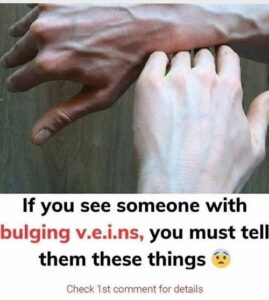Why Your Veins Suddenly Look More Prominent — And When to Be Concerned

Noticing your veins suddenly popping out can be surprising — and a little worrying — but in many cases, it’s perfectly normal. Your veins are constantly adapting to changes in your body, and several everyday factors can make them appear more pronounced. The key is knowing when it’s harmless and when it might point to an underlying issue.
Common Reasons Veins Stand Out
One of the most frequent culprits is exercise. Physical activity increases blood flow to deliver more oxygen to your muscles, temporarily enlarging veins. For athletes and bodybuilders, this vascular look is often a sign of good circulation and low body fat.
Age also plays a part. As skin naturally thins and loses elasticity over time, veins become easier to see. The tiny valves inside your veins may also weaken with age, allowing blood to pool and create a swollen appearance.
Temperature matters, too. Heat — from a sunny day or a hot shower — dilates blood vessels, making them more noticeable. Tight clothing can have a similar effect by restricting blood flow, forcing veins to work harder.
Genetics influence vein visibility as well. If prominent veins run in your family, you’re more likely to have them. Years of sun exposure can also thin the skin and weaken vein walls. Carrying excess weight puts extra pressure on veins, especially in the legs, which can make them bulge.
When Bulging Veins Signal a Problem
Most of the time, visible veins aren’t dangerous. But if you see discoloration, feel pain, notice swelling, or if the veins are warm and tender, it’s worth getting checked by a doctor.
A common medical cause is varicose veins — enlarged, twisted veins that usually appear in the legs but can also occur elsewhere. They develop when vein walls weaken or valves fail, causing blood to back up. Hormonal changes (such as pregnancy or menopause), excess weight, smoking, prolonged standing or sitting, and family history can all raise your risk.
Treatment & Risks of Varicose Veins
Mild cases often respond well to lifestyle changes, like wearing compression stockings, elevating your legs, and staying active. More stubborn cases may require medical procedures, including sclerotherapy (injections that close off the vein), laser therapy, or surgery.
Ignoring severe varicose veins can lead to complications such as venous ulcers (slow-healing wounds near the ankles) or dangerous blood clots. Deep vein thrombosis (DVT) — a clot deep inside the leg — can be life-threatening if it travels to the lungs and causes a pulmonary embolism.
How to Support Healthy Veins
You can’t always prevent vein issues, but you can lower your risk. Keep moving, maintain a healthy weight, avoid long periods of sitting or standing, and quit smoking. Opt for loose clothing that doesn’t constrict circulation.
Bottom line: Bulging veins aren’t always a cause for concern — sometimes they’re just a natural response to heat, movement, or genetics. But paying attention to accompanying symptoms and taking care of your circulation can help keep both your veins and your overall health in good condition.